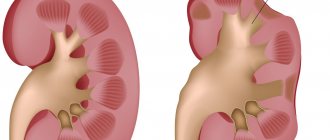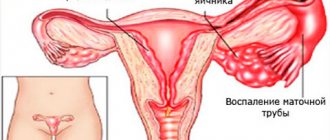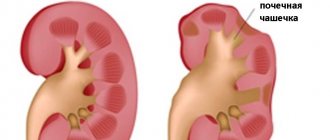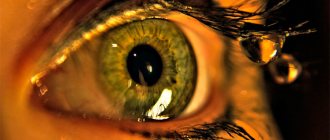In this article we will tell you:
- Causes of allergic conjunctivitis
- Classification of allergic conjunctivitis
- Drug-induced allergic conjunctivitis
- Large papillary allergic conjunctivitis
- Seasonal (hay fever) allergic conjunctivitis
- Chronic allergic conjunctivitis
- Infectious-allergic keratoconjunctivitis
- Vernal keratoconjunctivitis (spring catarrh)
- Symptoms of allergic conjunctivitis
- Treatment and prevention
Researchers have noted a high increase in the prevalence of allergic diseases. In some regions they come out on top, ahead of diseases of the cardiovascular system and oncology. In almost half of the cases, the organ of vision—the eyes—is involved in the allergic process. Due to exposure to allergens, a person may suffer from eyelid dermatitis, blepharitis and other diseases, but most often the diagnosis of “allergic conjunctivitis” appears in the patient’s card. How to treat the disease, as well as its symptoms, types and causes, read our article.
Allergic conjunctivitis
- an acute or chronic disease consisting of inflammation of the mucous membrane of the eye due to exposure to an allergen.
Inflamed eye capillaries
Price
Allergology-immunology
| Name of service | Price |
| Consultation with an allergist-immunologist, primary | 3 500 ₽ |
Advantages
- The latest, constantly updated equipment
- Interest-free installments for all services
- Online consultations with an ENT doctor
- Visit of an ENT doctor to your home
- Friendly and qualified staff
- 24/7 ENT assistance
Allergic conjunctivitis is a condition in which a person's eyes become inflamed when they come into contact with an allergen, a substance that causes the immune system to overreact to it. Allergic conjunctivitis differs from infectious conjunctivitis - the latter is caused by a virus, while an allergy is an incorrect reaction of the immune system to an objectively neutral substance.
Symptoms of allergic conjunctivitis can appear quickly, shortly after eye contact with the allergen. In other cases, such as if the reaction is caused by eye drops, symptoms may take 2 to 4 days to appear.
There is seasonal allergic conjunctivitis, which worries only at certain times of the year - usually from early spring to summer, and sometimes in autumn; and chronic year-round, when exposure to allergens can cause discomfort at any time of the year.
Allergic conjunctivitis in children develops similarly to the adult type.
The disease can have long-term effects on health and affect a person's quality of life. In some cases, complications are possible, so you need to contact a competent specialist and not tolerate unpleasant symptoms.
How to treat the disease?
The course of treatment under the supervision of a pediatric allergist lasts 10-14 days . If the therapy is well thought out, then the unpleasant symptoms disappear completely. First of all, avoid contact with the identified allergen. If this is not possible, the child is prescribed medications. If the form of the disease is mild, then “artificial tears” and cold compresses will be enough. For more severe forms, antiallergic drugs and medications that reduce inflammation are prescribed. The release form can be: tablets or eye drops.
Causes of allergic conjunctivitis
Signs of allergic conjunctivitis occur when an overreacting immune system causes the body to release histamine and other active substances to protect against the allergen. The blood vessels in the eyes dilate, which irritates the nerve endings. The result is increased secretion of tears and other symptoms.
Allergic conjunctivitis is usually caused by the following allergens:
- pollen,
- mold,
- animals,
- chemicals;
- dust mites;
- cosmetics;
- eye drops;
- contact lenses.
Why should you visit an allergist if conjunctivitis is an eye disease?
Since conjunctivitis is not a life-threatening disease, many people do not understand the need for it to be treated by two doctors at the same time. Allergic conjunctivitis has one feature. Very often it is accompanied by other ailments of an allergic nature. This could be rhinitis, diathesis, dermatitis, bronchial asthma, etc. An examination with an allergist will help identify the substance that is an allergen and causes discomfort. This allows you to prevent relapses of conjunctivitis and avoid serious complications, such as Quincke's edema. In some cases, treatment of allergic conjunctivitis can be carried out without the trials and tests that allergists usually perform. This happens in situations where the patient notes characteristic signs of allergies. For example, when the signs of allergy disappear after the plants finish flowering. In such cases, people often know what exactly causes the body's allergic reaction. Therefore, no testing is required.
Diagnosis of allergic conjunctivitis
The doctor diagnoses allergic conjunctivitis by examining the patient and asking in detail about the symptoms. The examination includes a thorough examination of the eyes with an ophthalmoscope.
If the allergen causing the reaction is unknown, a skin test is performed to identify it. In this case, the allergen is placed on the hand and at the same time injected internally; If you are allergic to this substance, your skin will experience itching and redness.
Diagnostics: what tests need to be taken?
This disease is diagnosed by a pediatric ophthalmologist and allergist. To develop a treatment plan, the following are prescribed:
- microscopy of lacrimal substance;
- skin tests;
- general blood analysis;
- analysis for determining the content of IgE (total) in blood serum Source: https://www.ncbi.nlm.nih.gov/pubmed/2669271 Akil H, Celik F, Ulas F, Kara IS Dry Eye Syndrome and Allergic Conjunctivitis in the Pediatric Population. Middle East Afr J Ophthalmol. 2015 Oct-Dec;22(4):467-71
Allergic conjunctivitis: recommendations to avoid
The best way to prevent allergic conjunctivitis of the eyes in both adults and children is to find out what causes it and avoid contact with the allergen.
If your allergies are caused by pets, try the following:
- Keep pets out of the bedroom;
- Wash them regularly every 2 weeks;
- Wash your bed linen regularly.
If you are visiting a home where there is a pet, taking an antihistamine an hour before will help reduce symptoms.
If pollen causes the reaction:
- stay home and keep doors and windows closed when pollen counts are high;
- avoid areas with a lot of grass, flowers or trees;
- Use sunglasses to protect your eyes.
If the reaction is caused by mites:
- minimize the amount of upholstered furniture in the house;
- choose anti-allergenic mattresses and bed linen;
- Vacuum frequently and wipe down furniture with a clean, damp cloth;
- use a vacuum cleaner with a HEPA filter.
If you are allergic to cosmetics and contact lenses, change the brand; To select brands, consult your doctor.
Diagnosis rules
In order for the doctor to make a diagnosis of “allergic conjunctivitis”, he needs to collect the most detailed medical history of the patient.
This process includes obtaining information:
- about the patient’s conditions and lifestyle;
- about the presence of chronic diseases;
- mode of work and rest;
- his occupation and hobbies.
This information is one of the main conditions for making a correct diagnosis. Therefore, it is necessary to answer the specialist’s questions clearly and truthfully. Often the doctor is interested in whether the patient has pets. Many people answer “no” unless they have cats or dogs. But pets also include others, for example: hamsters, decorative rabbits, ferrets, etc. Even dry food for aquarium fish, for example, dried daphnia, a type of planktonic crustacean, can be an allergen. The doctor will definitely pay attention to at what time the patient notices an exacerbation of the allergic reaction. This is of great importance for diagnosing the allergic form of conjunctivitis. For example, if allergy attacks worsen on weekends, then it is likely that the substance that provokes them is “homemade”. This could be animal fur or indoor plants. If the allergy reminds you of itself on weekdays, then its source is in the office or at work.
Treatment of allergic conjunctivitis
It is impossible to cure allergic conjunctivitis forever, but with the help of the selection of medications and the preventive measures described above, you can block its attacks. Symptoms of allergic conjunctivitis are treated with medication. It includes antihistamines, mast cell membrane stabilizers and corticosteroids.
Antihistamines
Antihistamines block the production of histamines. They act very quickly. Used as an inhaler or eye drops. Eye drops provide relief from eye symptoms, and an oral dose also helps relieve runny nose and other symptoms.
Mast cell membrane stabilizers
These drugs do not work as quickly as antihistamines, but once they begin to work, the effects last longer. They are available in the form of eye drops. Some patients are prescribed both antihistamines and mast cell stabilizers. Antihistamines provide some relief from symptoms before other medications take effect.
Corticosteroids
They are prescribed rarely and only for special forms of acute allergic conjunctivitis. A corticoid is a steroid hormone produced by the adrenal cortex. As a medication, synthetic corticosteroids can reduce swelling and reduce the body's immune response. Corticosteroids work effectively, but they should be used with caution and only for short periods of time as side effects may occur.
At the Ear, Nose and Throat Clinic, specialized doctors with many years of experience treat allergic conjunctivitis in children and adults. We find out how to treat allergic conjunctivitis most effectively in each specific case, and this allows our patients not to suffer from attacks of this pathology.
Seeing a doctor in a timely manner will help maintain your health.
Don't delay treatment, call right now. We work around the clock. tel. (24 hours a day)
Atopic keratoconjunctivitis
Atopic keratoconjunctivitis
Atopic keratoconjunctivitis is a rare inflammatory disease that mainly affects young people with atopic dermatitis (eczema).
The disease is asymptomatic for a long time, potentially causing serious damage to a person’s vision. Symptoms include:
- Itching in the eye area
- Redness
- Sensitivity to light
- Blurred vision
- Eyelids may be thick, red, and scaly
Giant papillary conjunctivitis
Giant papillary conjunctivitis
Giant papillary conjunctivitis is an inflammation caused by a reaction to an object in the eye, most often a contact lens. Sometimes this also happens after eye surgery.
Anyone experiencing severe symptoms should see a doctor immediately. These include:
- Severe eye pain
- Severe redness of the eyes
- Inability to open an eye
- Increased photosensitivity
- Vision problems
- Spots or blisters, near the eye, on the eyelid or nose
Additionally, if symptoms are mild but persist for a long time, you should also seek medical help.
Allergic conjunctivitis can affect people of any age, but is most common in young adults with a history of allergic diseases such as eczema, hay fever, allergic rhinitis and asthma.
Symptoms may be present for a short period of time, such as seasonally, when the allergen is a type of seasonal pollen, or throughout the year, such as when the allergen is dust or dander.
Allergic conjunctivitis is not contagious, which means it cannot be spread from one person to another.
Treatment at home
The following home remedies and over-the-counter treatments may help relieve the discomfort caused by conjunctivitis:
- Protect yourself completely from the allergen
- Avoid using contact lenses until the conjunctivitis resolves
- Use lubricating eye drops, these are called artificial tears.
- Avoid using eye makeup until the conjunctivitis goes away
- Use a cold compress
Vernal keratoconjunctivitis photo
Vernal Keratoconjunctivitis
Vernal keratoconjunctivitis is also a rare inflammatory disease that mainly affects young people, especially boys, in warm weather conditions. It can be seasonal or perennial (year-round), with symptoms typically worsening in the spring.










